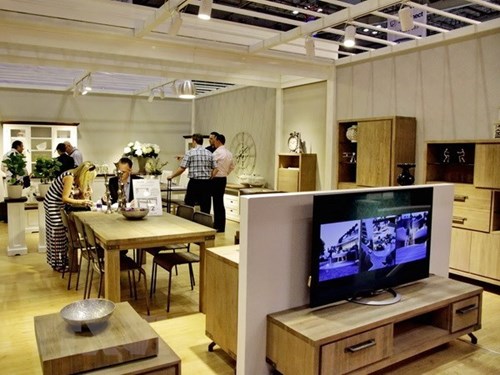The top four markets were the US, China, Japan and the Republic of Korea (RoK), together accounting for 78.1 percent of total export revenue. Strong growth was seen in the RoK and the US markets, with 45.3 percent and 9.7 percent respectively.
    |
 |
|
Vietnamese wooden furniture showcased in an exhibition.(Photo for illustration) |
In the first four months of 2018, Vietnam earned 1.1 billion USD from exporting wood and wooden products to the US, 367.3 million USD from China, 350.7 million USD from Japan and 288.8 million USD from the RoK.
However, Nguyen Quoc Khanh, President of the Handicraft and Wood Industry Association of Ho Chi Minh City, warned that the US, the largest market for Vietnamese wood and wooden products, has prioritised the domestic wood sector by reducing corporate income tax from 35 percent to 25 percent. He advised Vietnamese firms to supply different products from those produced en masse in the US.
Global demand for wooden furniture is rising, while producing wooden products is a strength of Vietnam.
Statistics from Canada showed that imports of wooden furniture of Canada in the first months of 2018 rose sharply, mostly from China, the US and Vietnam. Highest growth was seen in imports from Vietnam, accounting for 12.6 percent of total import revenue of the product.
Meanwhile, Japan’s imports of wooden furniture dropped in both volume and value. But Japan reduced imports from China and bought more products from Vietnam, resulting in an increase of 0.8 percentage point in Vietnam’s market share in Japan. This shows that Vietnamese wooden furniture has met regulations in the Japanese market.
Japan issued a Clean Wood Act in May 2017 to ensure the origins of wooden products sold in the country. This requires Vietnamese firms to ensure the legal and sustainable wood materials for products exported to Japan.
A study by Technavio, a market research firm with global coverage, showed office wooden furniture exports will expand 3.71 percent in 2017-2021 due to rising demand for high-end, assembled and environmentally friendly products.
In this context, Vietnamese firms should improve the design and quality of their products to match market trends and increase export revenue.
Khanh said that the panorama of the sector in 2018 and following years is bright, adding that increasing global market share will be easier for Vietnam as major producers are switching their focus to other industries. The objective of Vietnamese firms is to take advantage of this opportunity.
Source: VNA